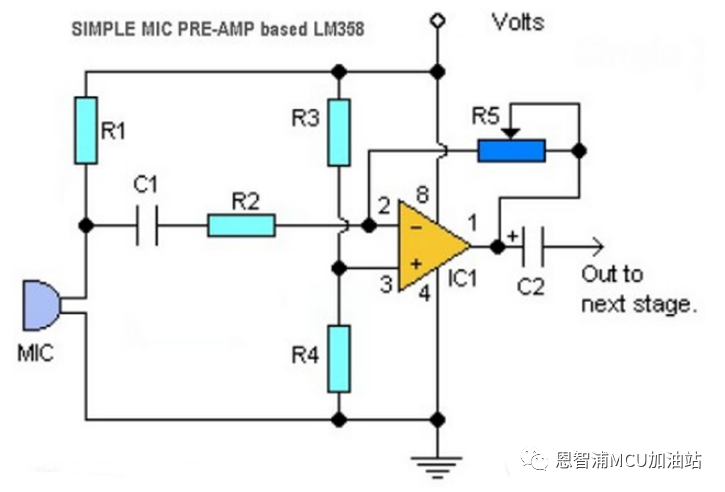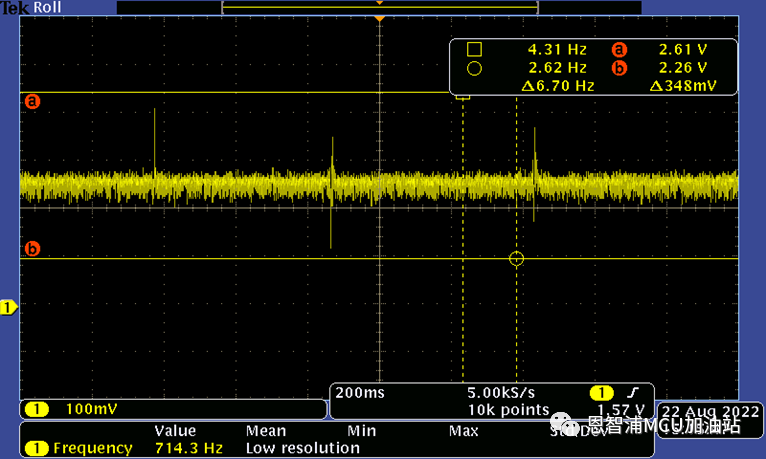最近在做一個(gè)有趣的小項(xiàng)目,其中有一小部分的內(nèi)容的是使用FFT做音樂(lè)頻譜顯示。于是就有了下面這個(gè)音樂(lè)頻譜顯示的低成本方案,話(huà)不多說(shuō),看看低成本MCU如何實(shí)現(xiàn)FFT音樂(lè)頻譜顯示吧。
?音頻采集硬件電路
音頻采集的硬件電路比較簡(jiǎn)單,主要的器件就是麥克風(fēng)和LM358運(yùn)放。

圖中電路R5可調(diào)電阻的作用是來(lái)調(diào)節(jié)運(yùn)放的增益。R4的作用的是給運(yùn)放一個(gè)VDD*R4/(R3+R4) 的直流偏置,這里加直流偏置是由于ADC只能采集正電壓值,為了不丟失負(fù)電壓的音頻信號(hào),給信號(hào)整體加了一個(gè)直流偏置。
但是這個(gè)圖還有一個(gè)小問(wèn)題,運(yùn)放的輸出端加了一個(gè)電容C2,C2會(huì)把直流偏置給隔掉。在設(shè)計(jì)時(shí),這個(gè)電容可以去掉。
下圖是按照上圖搭建的音頻采集電路的輸出信號(hào),圖中波動(dòng)信號(hào)是施加的外部音頻,是我們需要做音樂(lè)頻譜顯示需要的信號(hào)。該信號(hào)有一個(gè)2.3v的直流偏置,在后續(xù)處理時(shí)需要減去這個(gè)偏置。

為了呼應(yīng)標(biāo)題,我們選擇的MCU是LPC845,這是NXP的一款低成本的MCU。考慮到我們平常聽(tīng)的音樂(lè)頻率大都低于5kHz,在軟件設(shè)計(jì)時(shí)設(shè)置ADC采樣頻率為10kHz。不要問(wèn)為什么,問(wèn)就是采樣定理。
LPC845的ADC有8個(gè)觸發(fā)源,我們使用CTiimer match3來(lái)觸發(fā)ADC,將寄存器SEQA_CTRL的bit 14:12設(shè)置為0x5。CTimer match 3的輸出頻率為10kHz。
為了確保我們采集數(shù)據(jù)的實(shí)時(shí)性,DMA建議配置成雙buffer模式,以防止采樣的數(shù)據(jù)被覆蓋掉。
?FFT音頻信號(hào)處理
在DMA搬運(yùn)ADC采樣值時(shí),使用了雙buffer來(lái)搬,ADC采樣值需要減去一個(gè)2.3V的直流偏置。
Samples[]數(shù)組用于FFT計(jì)算。
//Calculate the FFT input buffer
if(g_DmaTransferDoneFlag_A == true)
{
for (i=0; i<128; i++)
{
Samples[i] =(int16_t)(((g_AdcConvResult_A[i] 0xfff0) >> 4) - 2979);//substract the 2.3v offset in the Amplifier output
}
g_DmaTransferDoneFlag_A = false;
}
else if(g_DmaTransferDoneFlag_B == true)
{
for (i=0; i<128; i++)
{
Samples[i] =(int16_t)(((g_AdcConvResult_B[i] 0xfff0) >> 4) - 2979);//substract the 2.3v offset in the Amplifier output
}
g_DmaTransferDoneFlag_B = false;
}
根據(jù)FFT算法的原理,在進(jìn)行FFT計(jì)算之前,還需要將ADC的采樣值Samples[]乘上一個(gè)窗函數(shù),這里我們使用的漢寧窗函數(shù),由于篇幅限制,具體原理可以去查看FFT算法相關(guān)的資料。
//If 'Window' isn't rectangular, apply window
if(Window == Triangular){
//Apply a triangular window to the data.
for(Cnt = 0; Cnt>L2Len;
else Samples[Cnt] = ((int32_t)Samples[Cnt]*((Len/2)-Cnt))>>L2Len;
}
}
else if(Window == Hann){
//Use the cosine window wavetable to apply a Hann windowing function to the samples
for(Cnt = 0; Cnt>L2Len;
Samples[Cnt] = ((int32_t)Samples[Cnt]*(int32_t)CosWindow[Index])>>(CWBD);
}
}
前面說(shuō)了這么多,F(xiàn)FT算法才是實(shí)現(xiàn)音樂(lè)頻譜顯示的關(guān)鍵部分(其實(shí)上邊每一步都缺一不可)。
我在網(wǎng)上找了好多FFT算法的資料,大家在做頻譜顯示時(shí),用到最多的就是CMSIS DSP的算法庫(kù)。于是乎,采用CMSIS DSP的庫(kù)貌似是首選。
但是不用不知道,一用才發(fā)現(xiàn),由于CMSIS DSP的庫(kù)使用的是查表的方式,我的64K Flash的LPC845輕輕松松就被撐爆了。沒(méi)辦法,只能改用其他方案。經(jīng)過(guò)不懈的查閱資料,在GitHub找到一份FFT算法的代碼,這個(gè)代碼寫(xiě)的非常簡(jiǎn)潔,而且用起來(lái)很好用,感謝發(fā)布者pyrohaz,下面是FFT代碼的一部分。
/* FIX_MPY() - fixed-point multiplication scaling. Substitute inline assembly for hardware-specific optimization suited to a particluar DSP processor. Scaling ensures that result remains 16-bit. */ inline short FIX_MPY(short a, short b) { /* shift right one less bit (i.e. 15-1) */ int c = ((int)a * (int)b) >> 14; /* last bit shifted out = rounding-bit */ b = c 0x01; /* last shift + rounding bit */ a = (c >> 1) + b; return a; } fix_fft(short fr[], short fi[], short m, short inverse)函數(shù),F(xiàn)FT計(jì)算函數(shù) int fix_fft(short fr[], short fi[], short m, short inverse) { int mr, nn, i, j, l, k, istep, n, scale, shift; short qr, qi, tr, ti, wr, wi; n = 1 << m; /* max FFT size = N_WAVE */ if (n > N_WAVE) return -1; mr = 0; nn = n - 1; scale = 0; /* decimation in time - re-order data */ for (m=1; m<=nn; ++m) { l = n; do { l >>= 1; } while (mr+l > nn); mr = (mr (l-1)) + l; if (mr <= m) continue; tr = fr[m]; fr[m] = fr[mr]; fr[mr] = tr; ti = fi[m]; fi[m] = fi[mr]; fi[mr] = ti; }
接 fix_fft(short fr[], short fi[], short m, short inverse)函數(shù)
l = 1;
k = LOG2_N_WAVE-1;
while (l < n) {
if (inverse) {
/* variable scaling, depending upon data */
shift = 0;
for (i=0; i 16383 || m > 16383) {
shift = 1;
break;
}
}
if (shift)
++scale;
} else {
/*
fixed scaling, for proper normalization --
there will be log2(n) passes, so this results
in an overall factor of 1/n, distributed to
maximize arithmetic accuracy.
*/
shift = 1;
}
接fix_fftr(short f[], int m, int inverse)函數(shù)
/*
it may not be obvious, but the shift will be
performed on each data point exactly once,
during this pass.
*/
istep = l << 1;
for (m=0; m>= 1;
wi >>= 1;
}
for (i=m; i>= 1;
qi >>= 1;
}
fr[j] = qr - tr;
fi[j] = qi - ti;
fr[i] = qr + tr;
fi[i] = qi + ti;
}
}
--k;
l = istep;
}
return scale;
}
/*
fix_fftr() - forward/inverse FFT on array of real numbers.
Real FFT/iFFT using half-size complex FFT by distributing
even/odd samples into real/imaginary arrays respectively.
In order to save data space (i.e. to avoid two arrays, one
for real, one for imaginary samples), we proceed in the
following two steps: a) samples are rearranged in the real
array so that all even samples are in places 0-(N/2-1) and
all imaginary samples in places (N/2)-(N-1), and b) fix_fft
is called with fr and fi pointing to index 0 and index N/2
respectively in the original array. The above guarantees
that fix_fft "sees" consecutive real samples as alternating
real and imaginary samples in the complex array.
*/
int fix_fftr(short f[], int m, int inverse)
{
int i, N = 1<<(m-1), scale = 0;
short tt, *fr=f, *fi= f[N];
if (inverse)
scale = fix_fft(fi, fr, m-1, inverse);
for (i=1; i
int fix_fft(short fr[], short fi[], short m, short inverse) 是FFT算法的計(jì)算函數(shù),fr[]是ADC采集到信號(hào)值的實(shí)部,fi[]是ADC采集到信號(hào)值的虛部。經(jīng)過(guò)fix_fft函數(shù)處理之后,fr[]是FFT計(jì)算所得實(shí)部,fi[]是計(jì)算所得的虛部。
我們最終要顯示的音樂(lè)頻譜其實(shí)是FFT頻域中音頻的幅值,幅值的計(jì)算是實(shí)部的平方+虛部的平方開(kāi)根號(hào)。下面是具體的幅值計(jì)算部分的代碼,每一個(gè)幅值點(diǎn)對(duì)應(yīng)OLED的一列像素點(diǎn)。
//Calculate the magnitude
for(Cnt = 0; Cnt>ColumnFilter; //calculate the DB
}
else{
Col[Index] += (BufSum-Col[Index])>>ColumnFilter; //calculate the amplitude
}
//Limit maximum column value
if(Col[Index] >= YPix-9) Col[Index] = YPix-10;
IndO = Index;
BufSum = 0;
}
}
來(lái)源:恩智浦MCU加油站
免責(zé)聲明:本文為轉(zhuǎn)載文章,轉(zhuǎn)載此文目的在于傳遞更多信息,版權(quán)歸原作者所有。本文所用視頻、圖片、文字如涉及作品版權(quán)問(wèn)題,請(qǐng)聯(lián)系小編進(jìn)行處理
審核編輯 黃宇
-
mcu
+關(guān)注
關(guān)注
146文章
17319瀏覽量
352650 -
adc
+關(guān)注
關(guān)注
99文章
6533瀏覽量
545757
發(fā)布評(píng)論請(qǐng)先 登錄
相關(guān)推薦
基于MCU的FFT音樂(lè)頻譜顯示方案
怎樣實(shí)現(xiàn)根據(jù)音樂(lè)跳動(dòng)的頻譜顯示
求基于單片機(jī)的音樂(lè)頻譜顯示設(shè)計(jì)
很炫的音樂(lè)頻譜——五彩音樂(lè)頻譜顯示器
基于RT-Thread+RA6M4的FFT音樂(lè)頻譜顯示器制作方案
音樂(lè)頻譜-PCB及代碼
基于增強(qiáng)型8051單片機(jī)的音樂(lè)頻譜顯示器的設(shè)計(jì)
MCU如何實(shí)現(xiàn)FFT音樂(lè)頻譜顯示
低成本 MCU 助力電池組系統(tǒng)實(shí)現(xiàn)強(qiáng)大功能

學(xué)校教學(xué)建議選擇低成本的USB頻譜儀

使用MSP430 MCU實(shí)現(xiàn)低成本語(yǔ)音





 如何用低成本MCU實(shí)現(xiàn)音樂(lè)頻譜顯示
如何用低成本MCU實(shí)現(xiàn)音樂(lè)頻譜顯示










評(píng)論